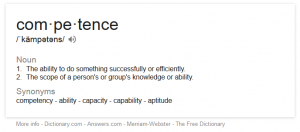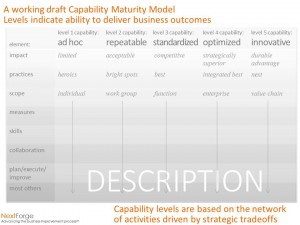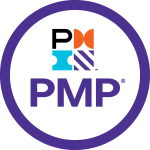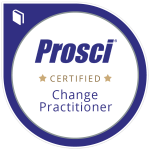 How are we doing?
How are we doing?
We typically focus on business performance – results delivered – when answering this question. For example, what was last month’s top-line revenue, or what is our gross margin for the quarter?
However, if we were to swing the spotlight to focus that question on our capabilities- our ability to deliver- you may take a long-pause, deflect the question, or remember something about a benchmarking study we did 8 years ago. We are often asked, “Are we that good, or are we just lucky?” If the business results are not driven by underlying capability, luck is often a good guess.
Strategy should define the requirements and guide the priorities for our capabilities. And yet, what is our scorecard for our capabilities? How do we, or should we, measure our readiness to deliver?
Our experience tells us we need some objective measure of readiness- some way we can observe, with reference points, how we are doing- and, possibly more importantly, where we are gapped.
 How do you think about capability or competence? In the mid-1990’s there was a movement by academics to push a business’ competence, most notably Prahalad and Hamel’s focus on core competencies- “a bundle of skills and technologies that enables a company to provide a particular benefit to customers1.” This mid-90’s rising awareness in business capabilities coincidentally, or perhaps not so coincidentally, paralleled the rise of probably the best known competency model- the software capability maturity model. Ever since, businesses continue to explore an expanding number of competency models. The following is a sampling of the business areas with developed capability maturity models.
How do you think about capability or competence? In the mid-1990’s there was a movement by academics to push a business’ competence, most notably Prahalad and Hamel’s focus on core competencies- “a bundle of skills and technologies that enables a company to provide a particular benefit to customers1.” This mid-90’s rising awareness in business capabilities coincidentally, or perhaps not so coincidentally, paralleled the rise of probably the best known competency model- the software capability maturity model. Ever since, businesses continue to explore an expanding number of competency models. The following is a sampling of the business areas with developed capability maturity models.
- Software (SW-CMM)2
- Business Process Management (BPM)3
- People (P-CMM)4
- Business Strategy-IT Alignment5
- Corporate Performance Management6
- Change Management7
- Business Intelligence (BI)8
- Social Business9
And the list goes on.
So, what exactly do all of these capability maturity models do and…
What’s In It For Me (WIIFM)?
Röglinger (2012) proposes three nested levels of uses for capability maturity models.
- Basic design principles to create a common language, including basic definitions and level of documentation
- Descriptive purpose of use to create a shared need for change, including integrated (cross-topic) objective criteria, assessment methodology, and basic design principles
- Prescriptive purpose of use to monitor for positive business improvements, including measures for each maturity level, decision calculus for selecting improvement measures, and adoption methodologies
The application of a capability maturity model (CMM) can provide an objective way for our organization to answer the question- How are we doing?
What makes up a Capabilities Maturity Model?
The best known capability maturity model, Carnegie Mellon University’s Software Engineering Institute’s (SEI) CMM, was initially commissioned by the US Air Force in the early 1990’s to increase the quality of software. Apparently SEI’s CMM has influenced the architecture of many of the capability maturity modeling following Watts Humphrey’s10 effort. Although we have not dug beyond Philip Crosby to understand what ultimately informed Humphrey’s and his successors’ work, there is a good chance a model we are all familiar with could be the basis. For example Maslow’s hierarchy of needs- advancing from physiological (food, water, shelter) to safety to belonging, self-esteem, and ultimately to self-actualization- seems a good candidate for providing the initial structure and understanding of the plethora of capability maturity models.
What we see by reverse engineering CMM models- an architecture for a CMM
Key observed characteristics of capability maturity models:
- 5 levels (+ level 0 in some cases)
- The CMM Structure
– Maturity levels indicate process capability
– Key process areas achieve goals
– Common features addressed or implemented or institutionalized
– Key practices describe infrastructure or activities
- Software process framework (a checklist for each level)
– Policy
– Standard
– Process
– Procedure
– Level overview
- Other (See “A working draft Capability Maturity Model”) including
– Business outcome including goals and measures
– Individual skills
– Organizational breadth
– Level of adoption/engagement
 With so many overlaps among models about real-business in the real-world, it all starts to sound a bit academic. The question we need to be asking ourselves in considering CMMs is “What is missing?” Based on our experience and research, we find the models are not mutually exclusive, nor collectively exhaustive (MECE)11. For example, thinking of the capability necessary for business in this hypercompetitive world [Porter, 1996], innovation within CMMs seems to be given only “continuous improvement” treatment.
With so many overlaps among models about real-business in the real-world, it all starts to sound a bit academic. The question we need to be asking ourselves in considering CMMs is “What is missing?” Based on our experience and research, we find the models are not mutually exclusive, nor collectively exhaustive (MECE)11. For example, thinking of the capability necessary for business in this hypercompetitive world [Porter, 1996], innovation within CMMs seems to be given only “continuous improvement” treatment.
So, where is innovation? For example, Gary Hamel considers multiple dimensions of innovation in his innovation stack- also presented in a near-CMM form (see “Hamel’s Innovation Stack”).
A working draft integrated CMM strawmodel: Key business elements
 After reviewing about 20 capability maturity models with varying business concentrations, we have developed a working draft for your consideration. A way for you: to test the test, to check the rigor of a model in use, or to help define requirements. Our five levels range from chaos to disruptive innovative. We boiled our list of elements down to but a few from the high teens.
After reviewing about 20 capability maturity models with varying business concentrations, we have developed a working draft for your consideration. A way for you: to test the test, to check the rigor of a model in use, or to help define requirements. Our five levels range from chaos to disruptive innovative. We boiled our list of elements down to but a few from the high teens.
We found most of the elements regarding capability maturity level clustered around an ever expanding collaborative scope e.g., from individual to work group to function to enterprise to value chain.
Since there are so many CMM’s out there, each with its own functional focus, it may be worth a few minutes to explore one possible future of an integrated maturity model- One which we could at least try to begin to migrate toward, instead of further fractionalizing elements. Perhaps a model parallel to the “general management” approach used at some business schools? In our closing post, we will lay out the foundation for an integrated maturity model, based on proven business frameworks, and take advantage of the growing awareness of the power of broad-based collaboration.
This is the opening post of a pair focused on measuring capabilities and specifically exploring the use of Capability Maturity Models. Also see the closing post “The Calculus of Capabilities- An integrated maturity model”
End notes
1 See Hamel & Prahalad, Competing for the future, (Boston, Massachusetts: Harvard Business School Press, 1994), p. 199.
2 See Paulk, et al, “Capability Maturity Modelsm for Software, version 1.1, Technical Report, CMU/SEI-93-TR-024, ESC-TR-93-177”, [Internet] February 1993, P 29. [cited May 6, 2013 Google search directly to PDF].
3 See Röglinger, et al, “Maturity Models in Business Process Management”, Discussion Paper WI-352, University of Augsburg, Business Process Management Journal, vol. 18, 2012, (19 pages). Authors profile 10 BPM capability maturity models.
4 See Curtis, et al, “People Capability Maturity Model (P-CMM) version 2.0 CMU/SEI-2001-MM-01”, [Internet] p. vi, July 2001, (735 pages). [cited May 6, 2013 Google search directly to PDF]
5 See Luftman, “Assessing Business-IT Alignment Maturity”, Communications of Association for Information Systems, [Internet] vol. 4, article 14, 2000 (51 pages). [cited May 6, 2013 Google search directly to PDF]
6 See Aho, “A capability maturity model for corporate performance management- An empirical study in large Finnish manufacturing companies”, [Internet] c. 2009 (20 pages) [cited May 6, 2013 Google search directly to PDF]
7 From “Learning is change. Change is learning.- Changing behavior to produce results” [internet] From author’s notes during 5.6.2013 webinar, Prosci® Change Management Maturity Modeltm [cited from webinar May 6, 2013].
8 See graphic model for business intelligence maturity. [Internet]. [cited May 7, 2013]. Available from TDWI’s toolkit http://tdwi.org/pages/maturity-model/maturity-model-home.aspx
9 See Wang, “Best practices: applying social business challenges to social business maturity models”, January 22, 2011 post [internet] [cited May 7, 2013]. Available from http://blog.softwareinsider.org/2011/01/22/best-practices-applying-social-business-challenges-to-social-business-maturity-models/; Also see Li and Solis, “The evolution of social business, six stages of social media transformation”, March 6, 2013, Altimeter Group (26 pages).
10 See Wikipedia referencing Humphrey, Managing the software process, 1989 [Internet] [cited May 7, 2013] Available from http://en.wikipedia.org/wiki/Capability_Maturity_Model. Also see from this Wikipedia post:- Reference to Crosby’s, Quality is Free, the “Quality Management Maturity Grid”- Capability Maturity Model Integration (CMMI) project
11 See mutually exclusive and collectively exhaustive (MECE) as a test for mental models and frameworks. [Internet]. [cited May 7, 2013]. Available from http://en.wikipedia.org/wiki/MECE_principle.







